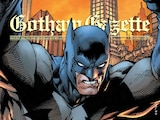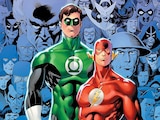Have you ever thought about what it takes to run a comic book publisher? It can be challenging work. Dozens of books, all with different creative teams, are released on an evenly distributed monthly schedule to ensure there’s quality material on the shelves every week. Publishers accomplish this by dividing their line into scheduled quadrants, so every week of the month brings with it a healthy new crop of comics. This system presents one inconvenient problem, though—sometimes, you get five weeks in a month.
So, what’s a comic publisher to do on that fifth week? Let the store shelves lay empty? Sorry, folks, come back next week? In 1995, DC decided that wasn’t a good enough answer and they began developing special comics and storylines for those last fractional weeks. This was the birth of the Fifth Week Event.

1995: Superman: Man of Tomorrow
Thanks to talent like John Byrne, Jerry Ordway, Roger Stern, Louise Simonson and Dan Jurgens, and headline making stories like The Death of Superman and Reign of the Supermen, not to mention both a highly popular live action and animated television series, the ’90s were a high watermark for Superman’s popularity. This was represented in the comics by what fans would dub the “Triangle Era,” for a triangular symbol found on ’90s-era Superman titles that served as a guide to following storylines that ran through multiple titles. By the mid-‘90s, the Triangle Era wound through four different comics—Superman, Adventures of Superman: Superman: The Man of Steel and Action Comics—ensuring a new Superman story every week.
DC’s first foray into fifth week capitalization was to create a fifth Superman title: Superman: The Man of Tomorrow. Written by Roger Stern, and later Louise Simonson, the issues of Man of Tomorrow represented major turning points in ongoing storylines, essential to Superman’s ongoing adventures which couldn’t be missed. But this was pretty similar to quarterly comics that DC had published in the past, like Justice League Quarterly. The Event factor, one which displayed an entire boutique line of comics for one week only, was yet to come.

1996: Amalgam Comics
DC’s most legendary Fifth Week Event was by some measures its very first: a rare collaboration with rival publisher Marvel Comics. In the wake of their most ambitious crossover to date, the DC vs. Marvel event, both publishers presented a joint line of Amalgam Comics, imagining an entirely new superhero universe where every character was a mash-up of a DC and a Marvel icon. Superman and Captain America were now Super-Soldier. Batman and Wolverine became Dark Claw. Wonder Woman and Storm combined into a hero known only as Amazon. Some amalgams were a comparison of themes, others a simple play on words (take, for instance, Doctor Doomsday). But the line proved so popular among fans and creators alike that it came back for a return performance the following year. These stories can be hard to track down now, but those of us who were there remember well when the Big Two played together on the same field.

1997: Tangent Comics
We covered Tangent earlier this month, but failed to mention the Amalgam aspect. Having already set a precedent for the Fifth Week Event, which established a remix of familiar concepts, Dan Jurgens wondered what that might look like if we removed Marvel from the equation. How radically could you reinvent the DC Universe if you changed absolutely everything about the characters but their names? With that, Tangent Comics was born. Like Amalgam, Tangent would return for an encore performance in the following year and to this day remains a fixture in the DC Multiverse as Earth-9.

1998: Heroines and Hypertime
1998 is really when the Fifth Week Event became a regular, dependable phenomenon, and something readers came to anticipate with each longer month of the year. In addition to a second batch of Tangent, DC used its Fifth Weeks to return to another legendary alternate universe: Mark Waid and Alex Ross’s apocalyptic Kingdom Come. With The Kingdom, fans of the hit original Elseworlds series could check in to see how the world was faring after the final battle between the world’s heroes of yesterday and its anti-heroes of tomorrow.
Two other events, “GirlFrenzy!” and “New Year’s Evil,” were published as a series of one-shots featuring new characters or ones who rarely got a chance in the spotlight. Some highlights of “GirlFrenzy!” would have a lasting legacy, like The Secret launching as a soft launch for Peter David’s Young Justice, and Batgirl setting the stage for writer Kelley Puckett to eventually take the reins for the first Batgirl ongoing comic—albeit, with a very different Batgirl in the role. “New Year’s Evil,” for its part, would most notably introduce one of the definitive villains of Grant Morrison’s JLA series, the hero-hunting Prometheus.

1999: Old Friends and New
DC’s plans for the close of the 20th century were a celebration of the first superhero team and a chance to take the Fifth Week Event outside of the DCU. Spring’s “The Justice Society Returns!” was a nine-issue crossover story featuring the JSA, setting the stage for their first ongoing series nearly fifty years since their creation. The story was told in a series of one-shots all bearing the name of a classic Golden Age series, from All-Star to Star-Spangled Comics.
In the summer, DC’s recent acquisition of WildStorm was given their moment in the fifth week spotlight. “Wild Times” was a series of one-shots which reimagined core WildStorm characters and teams in different eras and settings, much akin to DC’s Elseworld concept. Each WildStorm book even paired its hero with a temporally appropriate DC character for their trouble: Deathblow met Bat-Lash, DV8 met Sgt. Rock and Easy Company, Gen 13 met the Teen Titans, and Wetworks met Superman.
Organizing an event for Vertigo at the end of the year was a taller order, as the concept of a shared universe among its titles was always a lower priority than telling great stories by uninhibited creators. Instead, Vertigo opted to structure its winter Fifth Week Event around a theme. Dubbed “V2K,” the last Vertigo titles of the ’90s all told stories invoking the looming apocalyptic dread which everyone felt with the approach of the new century.

The 21st Century
Speaking of that century, the Fifth Week Events would continue into the early 2000s, with events like “Sins of Youth,” which swapped the ages of DC’s adult and child heroes; “Silver Age,” which recontextualized stories and concepts from the 1950s and ’60s for modern continuity; and “Justice Leagues,” which saw each core member of the JLA form a League of their own. (I already made that joke this month. That’s strike two.) The spirit of the Fifth Week Event even continues today, albeit in a different form, with quarterly anthologies that bring creative teams together to collaborate on a theme—horror in the fall, holidays in the winter (including today’s Grifter Got Run Over by a Reindeer), romance in the spring, and anything from animals to cyborgs in the summer.
In the DC Universe, you see, there’s no such thing as extra time. A fifth week is just another opportunity to show you what we’ve got.
Alex Jaffe is the author of our monthly "Ask the Question" column and writes about TV, movies, comics and superhero history for DC.com. Follow him on Twitter at @AlexJaffe and find him in the DC Community as HubCityQuestion.















